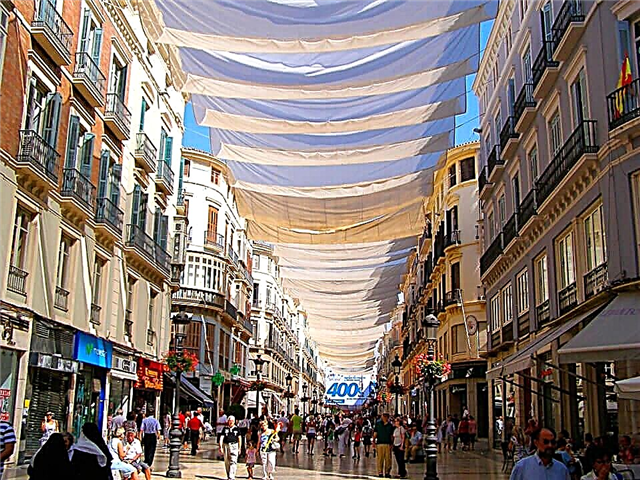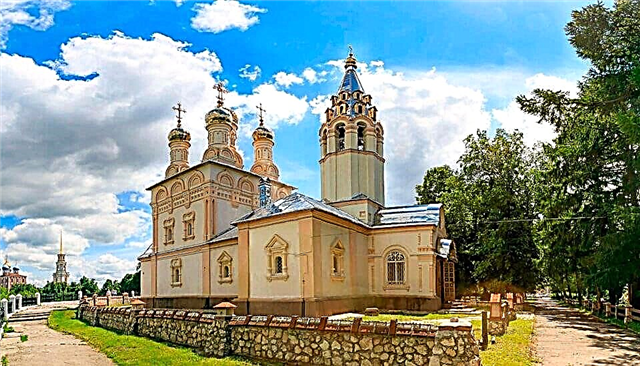The ruins of Mangup-Kale are located not far from Bakhchisarai, adjacent to the villages of Khadzhi-Sala and Zalesnoye. The exact date of the founding of the ancient city is unknown, but historians say that during the Middle Ages, Mangup-Kale served as the capital of the small but powerful principality of Theodoro. At different times this city was called Mangup, Mangut, Mankop and Man-Kermen.
How the city on the plateau was built
The city was located on the Baba-Dag plateau, which is very similar in shape to a four-fingered hand. Two right "fingers" were occupied by the city itself, and two left - dwellings of artisans and mountain pastures. Three approaches to the top of the plateau were between the "fingers".

The ruins of the citadel with the city gate
Due to the fact that the Baba-Dag plateau is surrounded by cliffs, Mangup-Kale has always been considered an impregnable fortress, which even the Ottoman Turks, experienced in military affairs, could not immediately capture.
The oldest archaeological finds found here date back to the Neolithic era, and they are mainly represented by stone tools. The active settlement of the Crimean plateau falls on the second half of the 3rd century AD.

Beautiful ornament around the window of the citadel
The most diverse peoples - Scythians, Taurus, Alans, Sarmatians, Armenians, Karaites, Tatars and Greeks - became residents of the principality of Theodoro. They lived together and were engaged in cattle breeding, viticulture, winemaking, as well as gardening and horticulture.
By decree of the Byzantine administration and Emperor Justinian I, work began on the plateau to build fortifications and a large basilica - a temple symbolizing the establishment of the Orthodox faith and consolidation of the power of Byzantium.

Main city gate
From the 5th to the 8th centuries, a powerful defensive system was created on the mountain plateau. At the same time, the ancient builders fully took into account and used all the features of the rocky landscape. The fortress walls crossed mountain gorges found in the north of the plateau, as well as narrow crevices of cliffs located on the slopes from the south and west. The system of fortifications stretched for 1.5 km, and the defensive contour with all obstacles reached 6.6 km. During this period the city was called "Doros" and it served as the capital of Gothia. The beginning of the 6th century is marked for the cave city by the fact that it receives the status of the center of the local diocese.

The graves carved into the rock
By the end of the 10th century, the settlement fell into decay, possibly due to an earthquake that damaged the entire peninsula. Since the XIV century, the city has become the center of Feodoro and, thanks to the skillful leadership of Prince Alexei, is experiencing a cultural and economic heyday. During this period, Mangup's external relations with other cities were developing, and the urban infrastructure was being improved.

View of the complex of the cave monastery Baraban-Koba
Since the Middle Ages, artificially created caves, the remains of the Citadel, parts of defensive walls and ancient basilicas have been well preserved on the Teshkli-Burun Cape (or Leaky Cape). However, the complex of the South Cave Cloister is considered the most solid historical monument of that era. You can get to the monastery courtyard through an artificial tunnel equipped with a staircase. Next to it are cells and a temple, for the construction of which it was necessary to cut through limestone rocks.

The premises of the cave monastery Baraban-Koba
On the Leaky Cape, there was once a Citadel with a princely residence inside. An octagonal temple was located near it, later turned into a mosque by the Turks. In the gorges of Kapu-Dere and Gamam-Dere, two Christian churches could previously be seen. Historians suggest that the church, built in honor of St. Constantine, gathered believers until the beginning of the 17th century, remaining the last temple for parishioners from the Christian community of Mangup-Kale.
Over the history of its existence, the principality of Theodoro with the center of Mangup-Kale was subjected to several invasions of the enemy. In 1299, the troops of Nogai invaded its territory, and a hundred years later - Khan Edigey. In 1475, Mangup was captured by the Ottoman troops, and a heavy six-month siege ended for the city with almost complete destruction.

Ruins of a church and sentinel defensive structures
The prefix "Kale" to the name "Mangup" was given by the Turks - in their language this word is translated as "fortress". Until the 18th century, the settlement on the plateau was a haven for the Ottoman garrison. However, after Crimea became part of Russia, Turkish soldiers had to leave their homes, and the city itself ceased to exist. It happened in 1774.

View of the surroundings from the ruins of Mangup-Kale
Attractions Mangup Kale
Today, when visiting the mountain plateau, you can only see the ruins of the ancient city. These are the fragments of the fortress walls and residential buildings, as well as the ruins of the prince's palace and stones from the Christian basilica of Helena and Constantine. The city gate is also preserved on the plateau. In ancient times, the western part of the city was inhabited by Karaites-tanners. Their craft is evidenced by stone vats for making leather, carved right in the rocks.

Ruins of the palace of Prince Alexei
The southern monastic complex has been inhabited by monks since the 1990s. Today, the Annunciation Monastery functions here, on the altars of which you can see many beautiful frescoes. The male abode on the plateau is not rich, but its inhabitants work hard to make the ancient monastery look better.

Holy Annunciation Cave Monastery
The main local legend is the Mangup boy, the relief of which was reproduced by modern masters at the end of the last century. According to an ancient legend, the defense of the city coincided with the death of the son of the ruler Mangup. And now the spirit of the young man wanders the neighborhood, breaking the silence with crying and revenge on strangers for his death. Therefore, superstitious Crimeans do not recommend walking along the plateau at night.

Winery
How to get to Mangup-Kale?
To get closer to the cave city, you need to take a regular bus in Bakhchisarai or go by personal transport to the village of Khadzhi-Sala. Then you will have to go on foot to the plateau along one of the beams. The ascent to the ruins of the city takes about an hour.

Ruins of Baselica - an early medieval Christian temple
If you want to visit the monastery, it is better to climb to it from the southern part of the mountain. To do this, after Khoja-Sal, drive about 1 km towards Ternovka. From here to the left along the valley there is a dirt road. From this road, from the foot of the plateau, there are paths that lead up to the monastery.
Attraction rating:











